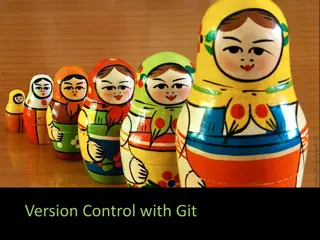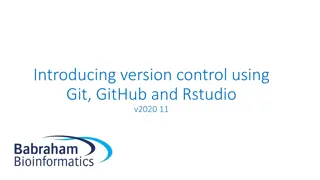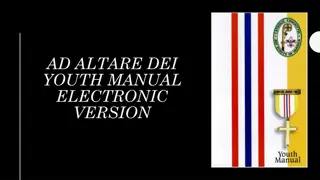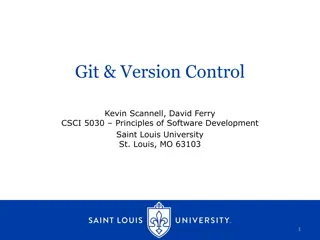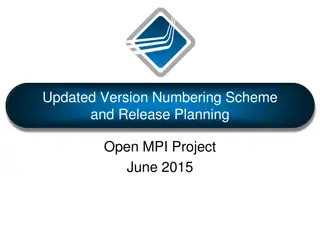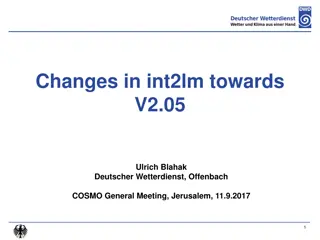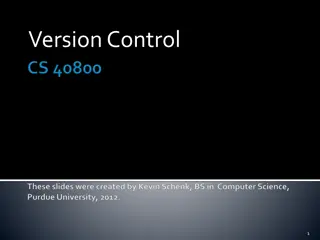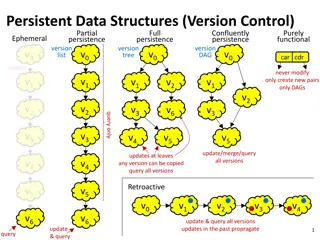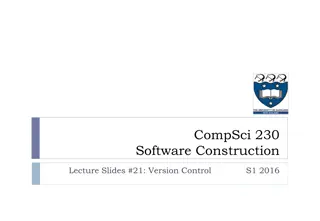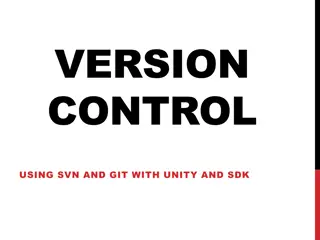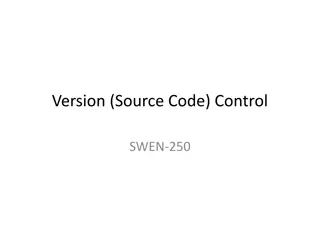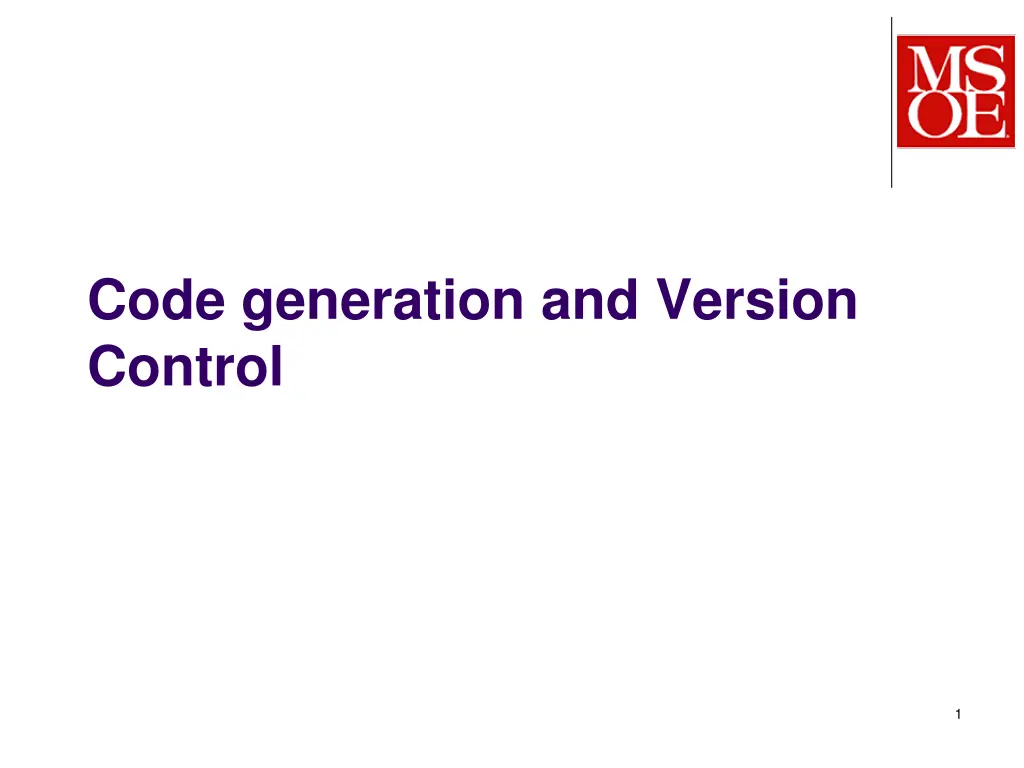
Efficient Code Generation and Version Control Practices
Learn about the importance of code generation and version control in software development. Discover how tools like Enterprise Architect make generating code from UML diagrams easier. Understand the challenges of managing multiple projects concurrently and the benefits of utilizing repositories to share files among team members.
Download Presentation

Please find below an Image/Link to download the presentation.
The content on the website is provided AS IS for your information and personal use only. It may not be sold, licensed, or shared on other websites without obtaining consent from the author. If you encounter any issues during the download, it is possible that the publisher has removed the file from their server.
You are allowed to download the files provided on this website for personal or commercial use, subject to the condition that they are used lawfully. All files are the property of their respective owners.
The content on the website is provided AS IS for your information and personal use only. It may not be sold, licensed, or shared on other websites without obtaining consent from the author.
E N D
Presentation Transcript
Code generation and Version Control 1
Code Generation Generating the class structure can be tedious Instance variables Class relationships Etc EA can generate stubbed code from UML Class diagrams! Demo Code Generation Tutorial https://emerald.msoe.edu/resources/doku.php?id=development_t ools:enterprise_architect:code_engineering 2
In many cases, multiple projects run concurrently New features are typically being added to the next version While at the same time, defects need to be corrected in existing releases 4
A team of software engineers work together toward a release All team members work on the same code and develop their respective parts An engineer may be responsible for an entire class Or just a few methods within a particular class 5
Files have to be shared among developers on a team project Shared files can be kept in some type of Repository where they can be accessed and worked on by multiple individuals Harry and Sally get their own respective local Working Copies of the Master File in the Repository 6 Image: http://svnbook.red-bean.com/
What might you use for a Repository? Would any of these work? USB/SD drive Private network drive E.g. shared X: drive Cloud drive Google drive Dropbox iCloud 7 Image: http://svnbook.red-bean.com/
Sharing files can lead to big problems Adds some method Modifies some other method 8 Image: http://svnbook.red-bean.com/
The problem to avoid: Harry s changes are still held locally Image: http://svnbook.red-bean.com/
Harrys changes are lost Harry s local file gets overwritten with Sally s latest changes. Image: http://svnbook.red-bean.com/
The Issue: Effective management of software artifacts, especially code Some acronyms: SCM Source Code Management RCS Revision Control System VCS Version Control System VC Version Control DVCS - Distributed Version Control Systems 11
Revision/Version History might help but USB/SD, private network drives do not maintain revision history Cloud drives (e.g. Google Drive, Dropbox, iCould/Time Machine) maintain a (limited) history of the various revisions of a file Google Drive: keeps last 100 revisions or last 30 days Supported in Classic mode only going away? IF you detect a collision, you can manually merge the differences and resynchronize your work Might be workable for two people what about 5 or 10? 12
Any other disadvantages to Google Drive/Dropbox/Box Security? Support (bug fixes and new features)? Ownership of stored information? Cost? Ease of Use? Acceptance? 13
History SCCS, 1972 (IBM) RCS, 1982 (Unix) SourceSafe 1995 (Microsoft) CVS, 1986 (multi-platform) SVN, 2000 (multi-platform) Git and Mercurial, 2005 (multi-platform) The way these work has changed over the years 14
Features of version control systems All changes to a file are tracked Version histories show who, what, when Changes can be reverted (rewound to any earlier version) Changes between revisions are easy to identify 15
The Lock-Modify-Unlock solution (RCS, SourceSafe) Early systems followed this model Sally must wait until Harry releases the lock, although she can retrieve a readonly version of the file in the meantime. Image: http://svnbook.red-bean.com/
Lock-Modify-Unlock only allows a single user to edit the file at a time Sally must continually poll the system to see if the file has been unlocked, or Harry needs to tell her when he unlocks it. Image: http://svnbook.red-bean.com/
Lock-Modify-Unlock has certain drawbacks: Harry has to remember to release his lock before Sally (or anyone else) can acquire the lock in order to edit Sally has to wait for Harry to finish before editing (editing must be done sequentially) Harry might be adding some new methods (takes a long time) Harry might forget to release the lock before going home (or on vacation!) 18
The Copy-Modify-Merge solution allows concurrent editing CVS, SVN use this model Harry adds new methods Sally adds comments 19 Image: http://svnbook.red-bean.com/
The Repository recognizes conflicts Harry is prevented from writing 20 Image: http://svnbook.red-bean.com/
Conflicting versions of the files are merged Conflicts are automatically resolved in many cases using robust merging algorithms. However, manual merging is sometimes necessary and can introduce errors. 21 Image: http://svnbook.red-bean.com/
The Repository keeps both users synchronized 22 Image: http://svnbook.red-bean.com/
Copy-Modify-Merge is generally easy to use and manage Users can work in parallel Most of the time, concurrent changes don t overlap People generally don t edit exactly the same code simultaneously, so merging is done automatically in many cases Amount of time spent resolving conflicts is nearly always less than the time that would be spent waiting for a lock to be released 23
Is Lock-Modify-Unlock ever needed anymore? When two or more people need to work on the same file, the simultaneous changes may not be mergable in all cases: MS Office documents Image documents Other binary files 24
Subversions is centralized A repository is typically hosted on a server. Version history is on the server, not on your local PC If the server or network become unavailable, everyone gets stuck with the working copy they have. 25 Image: http://svnbook.red-bean.com/
Distributed Version Control A remote master repository is typically hosted on a server. Clones of the remote repository are maintained on each user s computer If the server goes down, users can continue sharing code (provided they can connect over a network) by synch ing to each others repositories If the network is unavailable, users can continue reading & writing to their own local repository synch ing with others later Git and Mercurial use this model 26 Image: http://git-scm.com/book/
Git Commands clone Copy the entire directory status Shows local repo info about staged vs. unstaged files add Stages a new file in the local repo (first) commit Lock your changes into the local repo (second) push Sync your files to shared repo (third) pull Get updated files from the shared repo
Merging in a DVCS, part 1 1. Initially, both users repositories are synch d to the remote master; All files are identical. 2. Both users edit the same file, and their local repositories reflect their changes 29
Merging in a DVCS, part 2 4. User B attempts to push his repository to the remote to synch; this fails due to User A s earlier push. Remote does not change. 3. User A pushes her repository to the remote master to synch; this succeeds. 30
Merging in a DVCS, part 3 5. User B pulls User A s updates from the remote master, merging A and B together. Merging is automatic with some exceptions. 6. User B pushes his repository to the remote to synch; this now succeeds 31
Merging in a DVCS, part 4 7. User B pulls from the remote, and everyone is in synch again. 32
Installing/configuring Git You must have Git installed on your computer https://git-scm.com/download/win Default options are good YOU CAN SELECT YOUR DEFAULT EDITOR Notepad++ is a good option if you already use that. Or nano if you want a simple command line program 33
HTTPS vs SSH You may want to set up a public/private key pair to use SSH instead of HTTPS If you use HTTPS you will need to sign in every time you use a git command IntelliJ will save these settings for you, but other IDEs may not SSH is a more reliable, long term solution Please read this! http://jr0cket.co.uk/2016/05/ssh-or-https-that-is-the-github- question.html https://faculty-web.msoe.edu/yoder/se2030/Git#ssh 34
Git Commands clone Copy the entire directory status Shows local repo info about staged unstaged untracked files add Stages a new file in the local repo (first) commit Lock your changes into the local repo (second) push Sync your files to shared repo (third) pull Get updated files from the shared repo
Steps to git started Sign up at bitbucket.org Look for my invite Install git https://faculty-web.msoe.edu/hornick/Courses/se2030/SDL- InstallingtheGitclient-150916-1010-2.pdf Create an IntelliJ Project Initialize the git repo (only 1 person from a team) git init git remote add origin https://yourname@bitbucket.org/se2030riley/wc#.git git add . git commit m First commit git push origin master 1. 1. 2. 1. 3. 4. 1. 2. 3. 4. 5.
Lets try this together Make a change, push the change Pull changes from others What is happening??? Merge conflicts! 37
Further Considerations (cont.) Make sure to UPDATE REGULARLY otherwise you will have lots of conflicts Do a pull every time you turn on your machine to work! GIT will not help you if you do not COMMIT REGULARLY Do a push any time you make any working changes
WARNING You should not git add, commit, or push sensitive information to a remote repository. Sensitive information can include, but is not limited to: Passwords SSH keys AWS access keys API keys Credit card numbers PIN numbers Use .gitignore!!! 39
Git Ignore A .gitignore file in the root directory of your project specifies which files to skip *.class *.jar *.war *.ear What additionally should you ignore for IntelliJ? workspace.xml misc.xml 40
Further Considerations (cont.) Deleting a file in IntelliJ and then pushing will remove the file from the current repo push It will NOT remove it from the history Deleting a directory will not remove the file!
Repositories can also manage and track differences between parallel revisions of a document Typically, a software product will undergo parallel development on different branches (e.g. for new/future features) while primary development takes place on the main (master) branch More on this later 42 Image: http://svnbook.red-bean.com/
Credit: XKCD 43
Other resources https://www.youtube.com/watch?v=DR7MLa AKcUk https://www.udacity.com/course/how-to-use- git-and-github--ud775 https://www.youtube.com/watch?v=0fKg7e37 bQE




